Table of Contents Show
The longest highway tunnel in North America is located in Alaska, called the Anton Anderson Memorial Tunnel, a.k.a. the Whitter Tunnel.
It passes through over two miles of the Alaskan mountains. Let’s look at the Whittier Tunnel — where it is and how to travel through it safely.
So, the next time you plan a road trip to the Kenai Peninsula, you’ll know everything you need to know about this engineering marvel.
Let’s dive in!
Where Is the Whittier Tunnel?
Also called the Anton Anderson Memorial Tunnel, the Whittier Tunnel passes under Maynard Mountain in Alaska.
Vehicular access to the town of Whittier is only possible by traveling through the tunnel. It connects Whittier to Highway 1/Seward Highway, the main route from Anchorage to the end of the Kenai Peninsula.
Although the tunnel began as a rail-only tunnel, it’s now open to both train and vehicle traffic. Between September 1998 and mid-summer 2000, the Kiewit Construction Company upgraded the Whittier Tunnel to bimodal use.
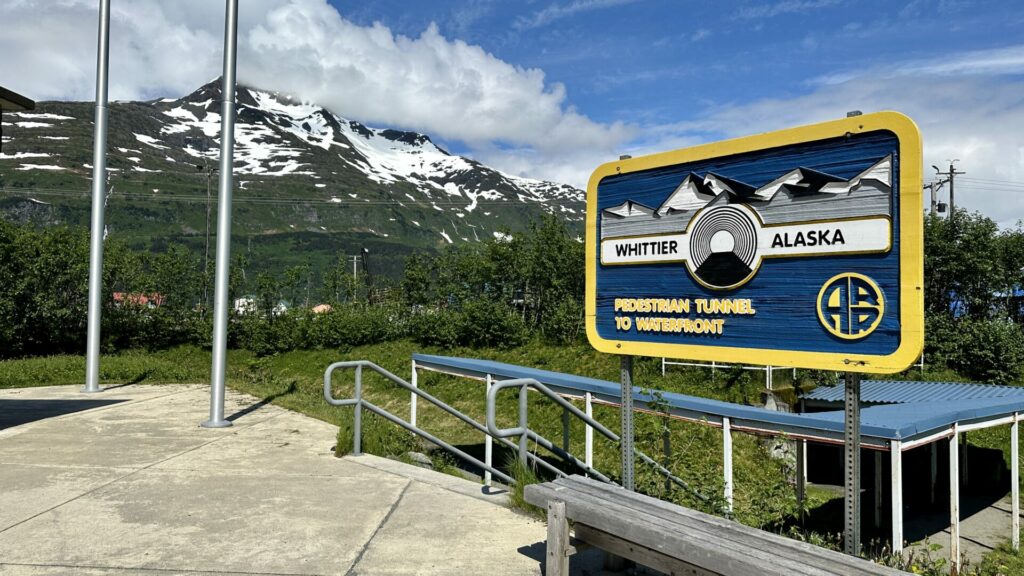
How Big Is the Whittier Tunnel?
The Whittier Tunnel is 2.5 miles long, taking about six minutes to travel through at 25 miles per hour. It’s North America’s longest highway tunnel and the longest combined rail and highway tunnel.
The maximum height of the tunnel at the center of the road is 22 feet, while only 15 feet high along the sides. It also has a 3-foot-wide emergency sidewalk.
Besides its size, the Whittier Tunnel is also famous because it was the first design-build highway project and the first O&M fee service contract in Alaska.
The tunnel has also won numerous awards, including the American Society of Civil Engineers’ Outstanding Civil Engineering Achievement.
About Anton Anderson
As mentioned earlier, the Whittier Tunnel is also called the Anton Anderson Memorial Tunnel.
Anton Anderson was the chief engineer for the project. He came to Alaska in 1919. But this project wasn’t his only claim to fame.
Anderson also served as the location engineer for the Matanuska Valley colonization project, engineer for the U.S. Army Corps of Engineers, chief engineer for the Alaska Railroad, and mayor of Anchorage.
Therefore, in 1976, the tunnel was dedicated to him in recognition of his service to the railroad and the state of Alaska.
Why the Anton Anderson Memorial Tunnel Built
Before the Whittier Tunnel, native people traveled Portage Pass and Portage Glacier to trade.
Later, miners and prospectors started making this journey. Portage Glacier still covered most of Portage Lake, and these travelers would climb the pass and walk across the glacier to the valley. This was a challenging and dangerous trek.
But, during WWII, the U.S. Army began constructing a railroad that would link Portage to Whittier to create a shorter voyage and reduce the exposure of ships to Japanese submarines. Plus, climbing the steep mountains was nearly impossible.
So, the 1940s brought about change in this small town. New buildings, more people, and supply ships changed the landscape and culture. Even after the war, Whittier became a federally-run commercial port.
Learn More: Read The Quirky Reasons We Love Whittier, Alaska to learn more about this unique Alaskan town!
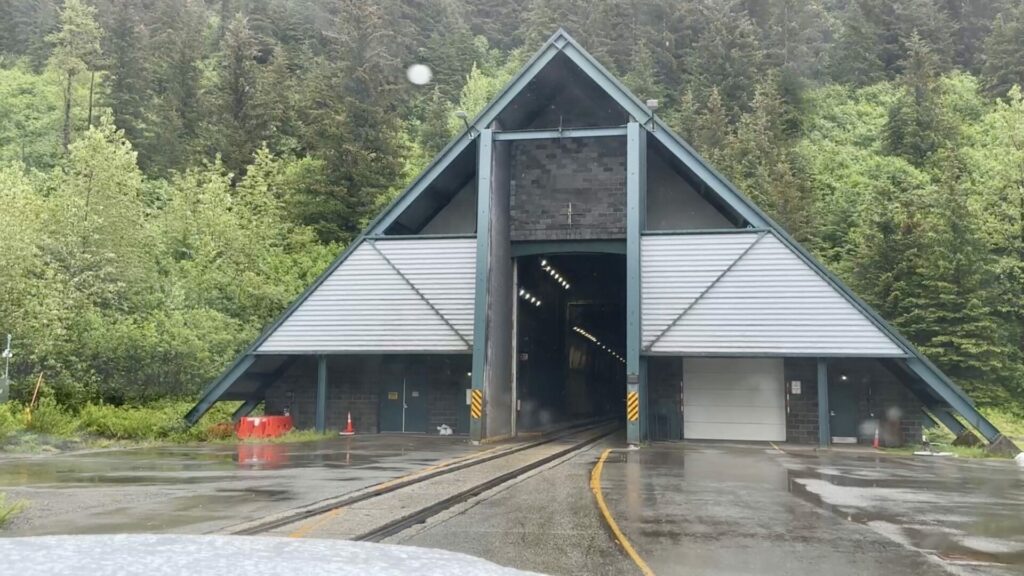
What Is the Inside of Whittier Tunnel Like?
The inside of the Whittier Tunnel is exposed rock and concrete panels. As you travel the 2.5 miles, you’ll notice pull-outs for disabled vehicles and safehouses in case of earthquake or fire.
The speed limit is 25 miles per hour. With a tunnel this long, the engineers also had to ensure proper airflow. So you’ll see portable fans and reversible jet fans to keep the air moving.
In case of a power failure, it has two backup generators.
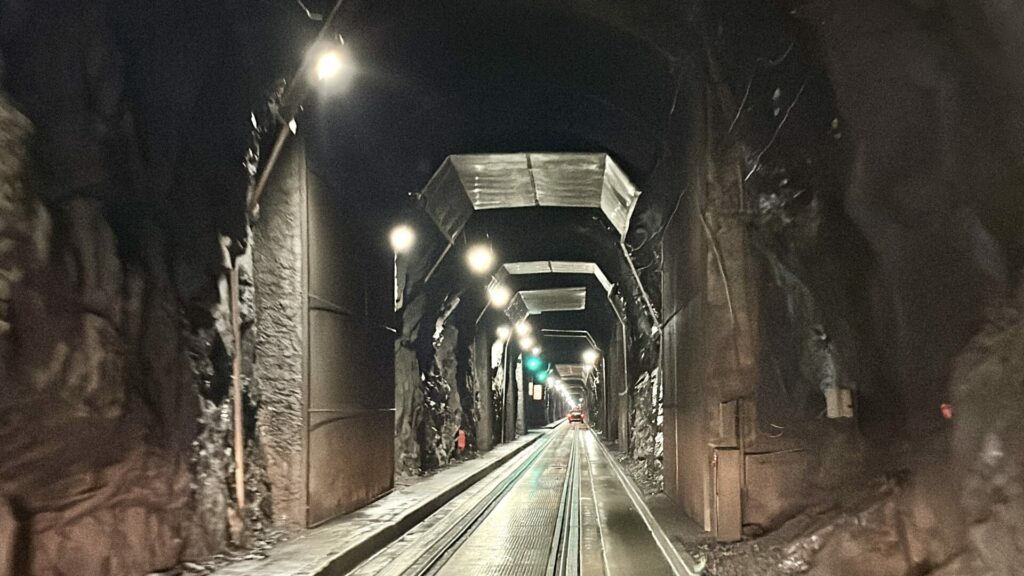
Is the Whittier Tunnel Two Lanes?
Vehicular and railroad traffic share the Whittier Tunnel. But it can only fit one-way traffic. Therefore, two computer-based systems control the timing and spacing.
The Train Signal System directs the railroad traffic, while the Tunnel Control System directs vehicular traffic.
Trains and cars are never in the Whittier Tunnel at the same time. This is another reason to have the two backup generators. The outcome could be catastrophic if these two systems didn’t operate accordingly.
If traveling through the Whittier Tunnel, allow yourself an extra 15 to 30 minutes. There may be a train coming through, an emergency, or a long line of one-way traffic.
Is There a Schedule to Drive Through the Anton Anderson Memorial Tunnel?
Traveling through the Whittier Tunnel is complicated. Vehicles don’t just have a stoplight or official guiding traffic.
Cars travel through the tunnel according to vehicle class. The spacing is varied according to class.
For example, the distance between buses will be greater than between standard cars. This reduces the risk of fire spreading through the tunnel.
In addition, the number of buses traveling through the tunnel is also limited. Should there be a reason to use the safe houses, there must be enough room to accommodate everyone on a bus.
Commercial trucks are the last class to travel through the tunnel. This is because they have a higher fire risk, and officials want to have most vehicles through the tunnel before allowing commercial trucks to pass through.
They also travel slower and could potentially hold up traffic, creating too many cars in the tunnel at one time. The schedule and operating procedures of the Whittier Tunnel have been thoroughly thought through to ensure everyone’s safety.
When you arrive at the tunnel, vehicles wait in a staging area. During the summer, traffic starts at 5:30 a.m. and continues until 11:15 p.m.
During the winter, traffic starts at 7:00 a.m. and continues until 10:45 p.m. Departure times are every 15 minutes. You can read more about the Whittier Tunnel schedule on the Alaska DOT website.
Read On: Can You Drive an RV Through Needles Eye Tunnel? Click to find out!
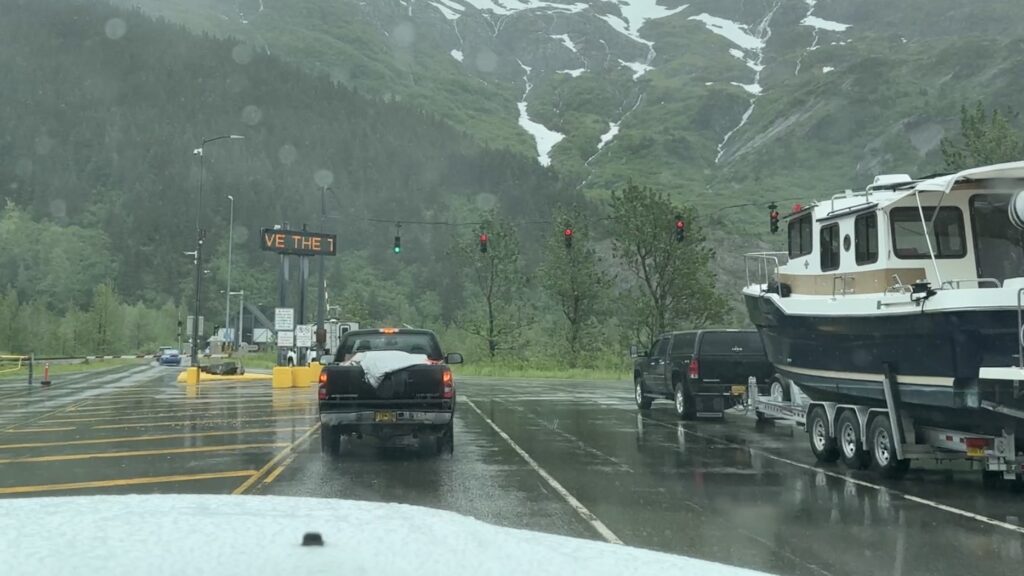
Are RVs Allowed to Drive Through the Whittier Tunnel?
During normal operations, you’ll have size limitations when traveling through the Whittier Tunnel. Vehicles must be less than 10 feet wide, 14 feet tall, and 80 feet long.
Any vehicle greater than these dimensions must use the tunnel during special openings.
However, even during these special times, vehicles can’t exceed 11 feet in width or 15 feet in height. These special times are 6:30 to 6:45 a.m., 8 to 8:15 a.m., 2:30 to 2:45 p.m., and 4 to 4:15 p.m. Monday through Thursday only.
Overweight vehicles are never permitted to use the Whittier Tunnel.
Are Bicyclists and Pedestrians Allowed In the Whittier Tunnel?
Bicyclists and pedestrians cannot use the Whittier Tunnel. It’s unsafe for bicyclists because of the grooves adjacent to the rails.
Plus, the vehicle detection system that ensures the tunnel is clear before allowing trains to pass through cannot detect bicyclists or pedestrians.
It’s also unsafe for bicyclists and pedestrians because the road isn’t wide enough to allow vehicles to pass safely. The 15-minute intervals apply to cars, too. People can’t travel this quickly by bike or foot.

How Much Is the Toll to Drive Through the Whittier Tunnel?
Tolls range from $13 for passenger vehicles to $330 for Class E vehicles. These vehicles include trailers between 10 and 11 feet wide and 14 to 15 feet tall, requiring special permits to travel through the Whitter Tunnel at the designated times Monday through Thursday.
You can also purchase books of 10 tickets, 30 tickets, and seasonal passes.
Recreational vehicles less than 28 feet long but not pulling trailers will pay $13. RVs less than 28 feet long, but towing trailers and RVs over 28 feet long will pay $22.
RVs over 28 feet and pulling trailers will pay $38. You can read more about the tolls required to drive through the Whittier Tunnel on the Alaska DOT website.
Keep in Mind: If you’re a movie lover, you need to add the Mt. Hollywood Tunnel to your bucket list!
Is the Anton Anderson Memorial Tunnel Safe?
As already mentioned, the Whittier Tunnel has multiple safety features. The computer systems ensure that passenger vehicles and trains can’t enter simultaneously. It also has more than 60 video cameras throughout the tunnel.
These safety measures have almost eliminated accidents. Only one car accident has occurred, making the Whitter Tunnel one of the safest places to drive in the entire country.
The biggest danger to driving through the tunnel is the limited clearance. Drivers must stay alert and drive the posted speed limit. They should also keep their wheels from moving directly on the rails so they don’t lose control of their vehicle.
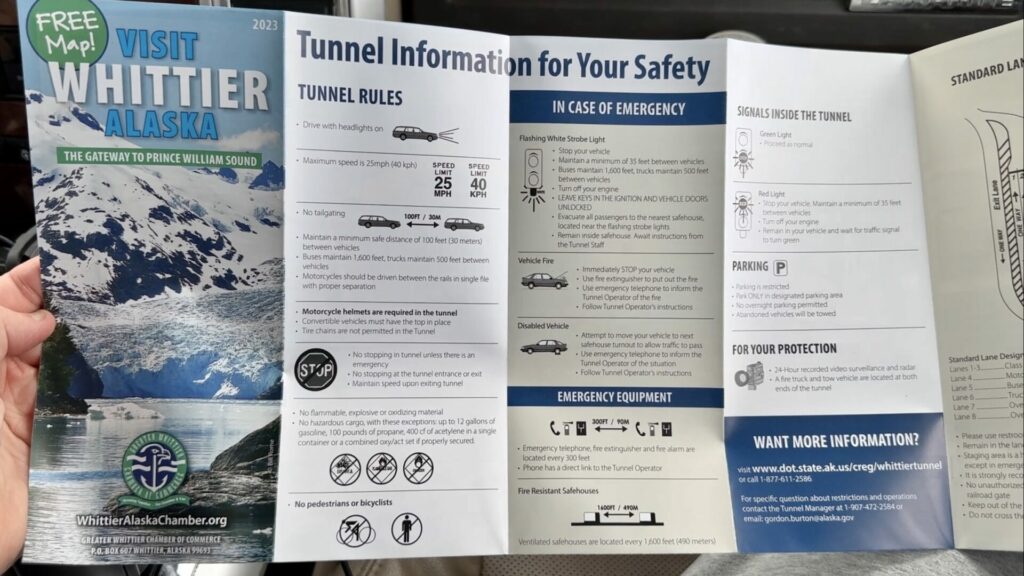
Traveling From Portage to Whittier, Alaska? Experience the Engineering Marvel of the Whittier Tunnel
Whitter Tunnel in Alaska is an engineering marvel like the Hoover Dam and the Golden Gate Bridge.
Instead of spending tens of millions of dollars constructing a second tunnel for vehicular traffic, engineers built a unique concrete panel structure to allow a single lane of traffic to drive over the railroad tracks. It’s truly remarkable!
So, the next time you travel from Portage to Whittier, give yourself some extra time to travel through the Whittier Tunnel.
Then, when you reach the other side, spend a few days in Whittier, enjoying the sights and sounds of this important Alaskan city.






